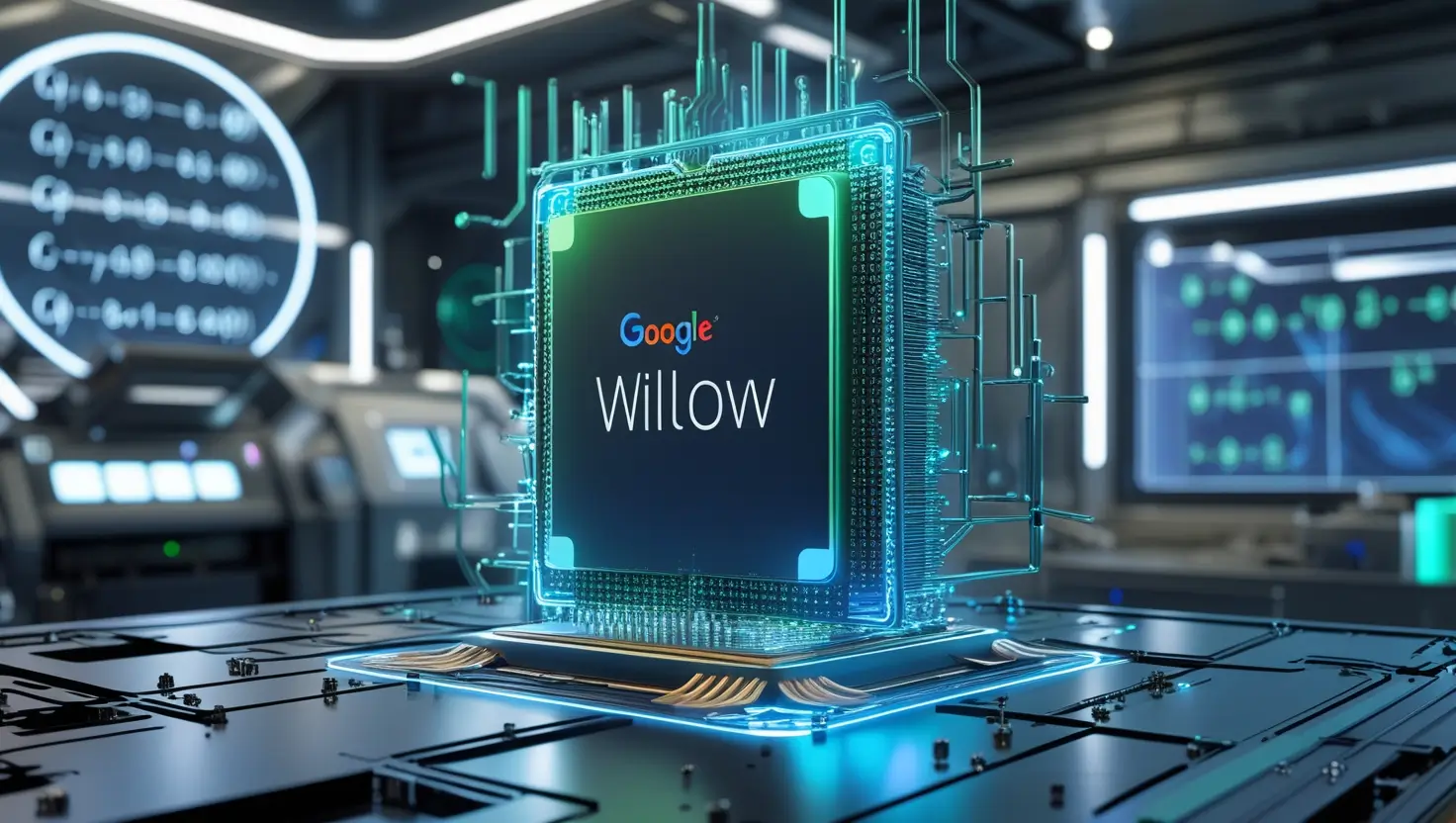Google’s Willow Chip: A Revolutionary Leap in Quantum Computing

Google’s Willow Chip: A Quantum Leap in Computing
Redefining Innovation in Quantum Technology
My name is Zainzee, and I warmly welcome you to ThriveableTech’s page. Today, we explore one of the most groundbreaking innovations in quantum computing—Google’s Willow Chip. Staying true to its legacy of technological excellence, Google has developed this high-quality chip featuring 105 qubits, positioning it as a frontrunner in the race for quantum supremacy.
What Makes Google’s Willow Chip Revolutionary?
The Willow Chip is designed to solve complex problems within minutes, problems that would take traditional computers years or even decades to compute. This innovation represents a monumental leap ahead of conventional computing technology, setting new benchmarks for speed, efficiency, and problem-solving capability.
To ensure accuracy and stability, the Willow Chip addresses the challenges of quantum errors with precision engineering, making it a highly reliable experimental system. Though still in its testing phase, the potential applications of this chip are immense and could redefine the boundaries of technology across industries.
Why Does Google’s Willow Chip Matter?
Quantum computing, once a subject of academic research and science fiction, is now transforming industries ranging from healthcare and finance to logistics and artificial intelligence. At the forefront of this revolution, Google’s Willow Chip is paving the way for practical and scalable quantum computing solutions.
This advanced chip is not just a breakthrough; it’s a glimpse into a future where quantum computing becomes a tool for everyday innovation. While the Willow Chip is not yet being utilized on a wide scale, ongoing research is uncovering possibilities that extend far beyond current technological limits.
The Road Ahead
As the journey of quantum computing continues, Google’s Willow Chip stands as a symbol of what’s possible when cutting-edge research meets ambitious vision. In this blog, we’ve explored its significance, potential impact, and the principles driving its development.
Key Features of the Google Willow Chip
The Google Willow Chip represents a groundbreaking leap in the field of quantum computing, setting new benchmarks in performance, efficiency, and scalability. Below are its key features:
Increased Qubit Count
The Willow Chip boasts an unprecedented number of qubits, enabling quantum computers to perform more complex computations and simulations. With higher qubit density, the chip facilitates advanced problem-solving capabilities, unlocking opportunities to tackle problems previously deemed insurmountable for classical systems.
Enhanced Quantum Error Correction
Error correction remains one of the most significant challenges in quantum computing due to the fragile nature of qubits. Google’s Willow Chip incorporates innovative error-correcting algorithms, ensuring greater reliability and computational accuracy. By addressing quantum decoherence and minimizing operational errors, it significantly improves the consistency of quantum computations.
Energy Efficiency
Quantum computers are often energy-intensive due to their cooling requirements and intricate circuitry. However, Google’s Willow Chip incorporates advanced cooling systems and optimized circuitry design, drastically minimizing energy consumption. This innovation not only lowers operational costs but also aligns quantum computing with sustainable practices, making it more environmentally friendly.
Scalability
One of the most remarkable features of Google’s Willow Chip is its modular design, which allows for seamless integration into larger quantum systems. This scalability paves the way for creating quantum networks and distributed computing infrastructures, bringing us closer to a fully interconnected quantum ecosystem.
How the Willow Chip Refines Quantum Computing
Google’s Willow Chip is not merely an incremental technological advancement; it represents a paradigm shift in quantum computing. Below are the transformative aspects of this revolutionary chip:
1. Accelerating Problem Solving
Quantum computers equipped with Google’s Willow Chip can solve problems in minutes that would take classical supercomputers thousands of years. This extraordinary computational speed has far-reaching implications across multiple domains:
- Drug Discovery: By simulating complex molecular interactions, Google’s Willow Chip accelerates the development of new medicines and treatments, potentially revolutionizing healthcare.
- Cryptography: The chip’s immense processing power enhances encryption techniques and can even break existing cryptographic systems, pushing the boundaries of cybersecurity.
- Logistics Optimization: Large-scale supply chain challenges can be streamlined with advanced quantum algorithms, improving global business operations and reducing inefficiencies.
2. Democratizing Quantum Research
Google’s commitment to making quantum technology accessible is evident in its open-source initiatives and collaborations with academic institutions. Google’s Willow Chip has been designed to foster inclusivity in quantum research, providing researchers and students worldwide with the tools needed to innovate in fields ranging from physics to artificial intelligence.
3. Strengthening Artificial Intelligence
Google’s Willow Chip’s capabilities have the potential to revolutionize artificial intelligence. By accelerating machine learning algorithms, it enables faster training of AI models, thereby enhancing their efficiency and precision. Applications include:
- Natural Language Processing: More accurate and nuanced language models.
- Autonomous Systems: Improved decision-making capabilities for self-driving cars and drones.
- Predictive Analytics: Enhanced forecasting models for various industries, from retail to energy.
Real-World Applications of the Google Willow Chip
The Willow Chip’s potential is not limited to theoretical advancements; it holds promise for real-world applications across numerous sectors. Some of these applications include:
1. Climate Modeling
Climate change poses a critical challenge to humanity, and accurate predictions are essential for effective policy-making. Quantum simulations powered by the Willow Chip provide unprecedented precision in climate modeling, enabling scientists to develop better strategies for disaster preparedness and environmental conservation.
2. Financial Modeling
In the finance sector, quantum computing can revolutionize portfolio optimization, risk analysis, and market trend predictions. The Willow Chip’s advanced capabilities empower financial institutions to make data-driven decisions with higher accuracy and efficiency, potentially saving billions of dollars in operational costs.
3. Space Exploration
Quantum computing is pivotal for space missions, where precise simulations and calculations are crucial. Agencies like NASA could leverage the Willow Chip to perform advanced trajectory planning, spacecraft design, and interplanetary mission simulations, accelerating humanity’s exploration of the cosmos.
Challenges and the Road Ahead
Despite its immense promise, the Google,s Willow Chip faces several challenges that need to be addressed for widespread adoption and long-term viability:
Technical Barriers
Quantum systems are inherently fragile, and issues such as quantum decoherence and high error rates remain significant obstacles. While the Willow Chip’s enhanced error correction is a step in the right direction, further advancements are needed to achieve truly stable and reliable quantum operations.
Cost
The development and maintenance of quantum systems are prohibitively expensive, limiting accessibility to only a select few organizations and institutions. Google’s efforts to reduce these costs and democratize quantum computing will play a critical role in determining the technology’s future.
Ethical Concerns
The ability of quantum computers to break current encryption standards raises serious security and privacy issues. If misused, this capability could compromise global data security. Google’s commitment to ethical research and its partnerships with policymakers are crucial in mitigating these risks.
Conclusion
The Google,s Willow Chip is a monumental milestone in the evolution of quantum computing. With its increased qubit count, advanced error correction, energy efficiency, and scalability, it sets the stage for unprecedented computational capabilities. From accelerating problem-solving in drug discovery and cryptography to revolutionizing climate modeling and AI, the Willow Chip has transformative potential across diverse fields.
However, realizing this potential requires addressing technical, economic, and ethical challenges. Google’s proactive approach to innovation, inclusivity, and ethical research offers hope that these challenges can be overcome. As we stand on the cusp of a new quantum era, the Willow Chip symbolizes both the promise and responsibility that come with groundbreaking technological advancements. Its impact is not just a technological upgrade but a redefinition of what quantum computing can achieve for humanity.
FAQs About Google Willow Chip
1. What is the Google Willow Chip?
The Google Willow Chip is a next-generation AI processor developed by Google to enhance machine learning performance, specifically designed for advanced AI models, natural language processing, and efficient energy consumption.
2. What makes the Google Willow Chip unique compared to other AI chips?
The Willow Chip features cutting-edge technology like ultra-high bandwidth memory (HBM), advanced tensor cores, and a proprietary architecture optimized for AI workloads. It focuses on reducing latency and power consumption while delivering exceptional computational power.
3. What applications does the Google Willow Chip support?
The chip supports a wide range of applications, including generative AI models like ChatGPT, deep learning, image recognition, robotics, and large-scale data analysis. It is also ideal for powering Google’s AI services and products.
4. Is the Google Willow Chip available for public use?
Currently, the chip is primarily used internally by Google to power its AI services, but future versions may be available for external developers and businesses through Google Cloud platforms.
5. How does the Google Willow Chip contribute to sustainability?
The Willow Chip is designed to be energy-efficient, significantly reducing the environmental impact of running large AI models. Its low-power architecture aligns with Google’s commitment to sustainability.
6. What industries can benefit from the Google Willow Chip?
Industries like healthcare, automotive, finance, and entertainment can benefit from the chip’s capabilities. For instance, it can accelerate drug discovery, enhance autonomous driving systems, and improve real-time data processing for financial transactions.





0 Comments